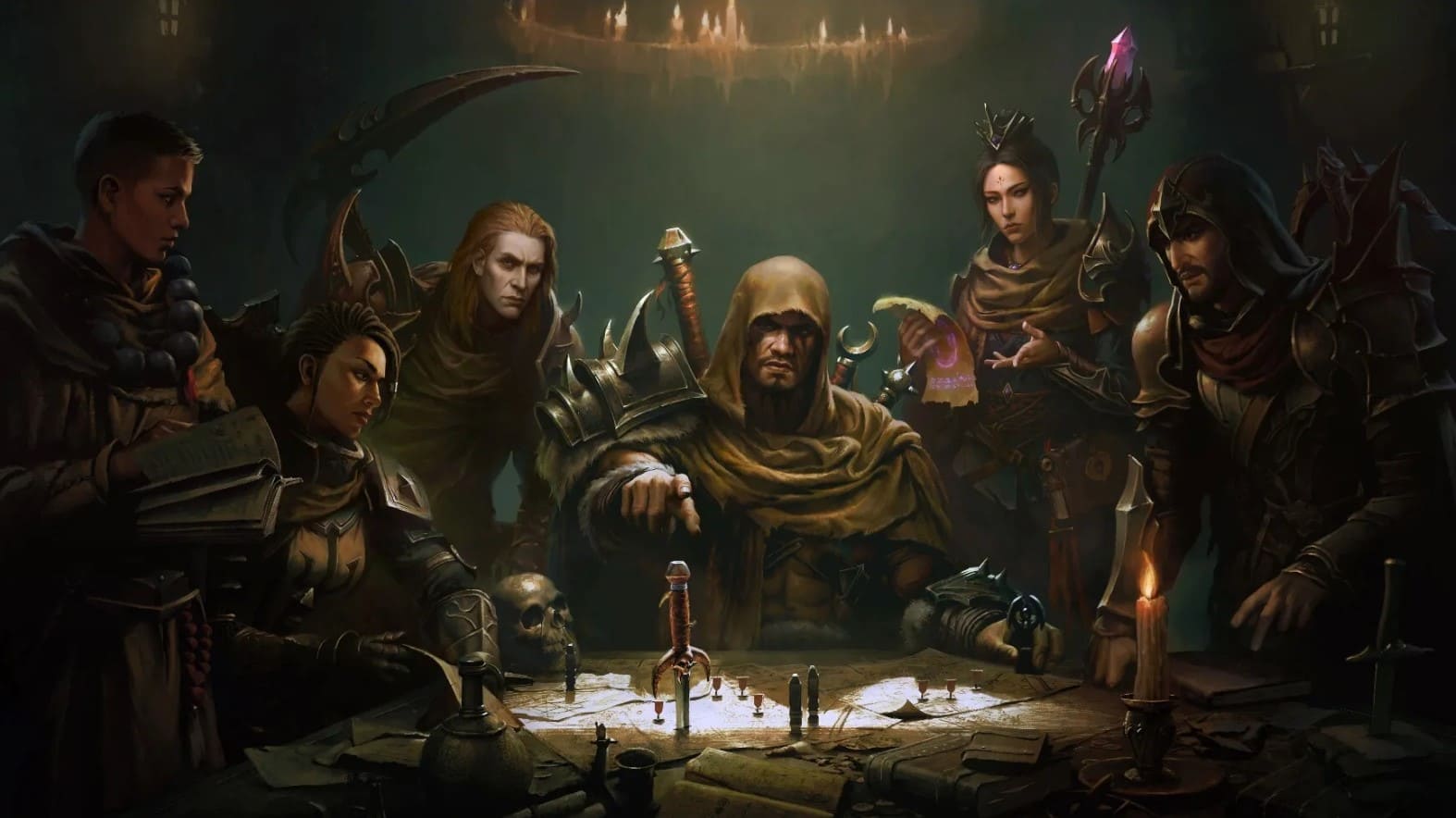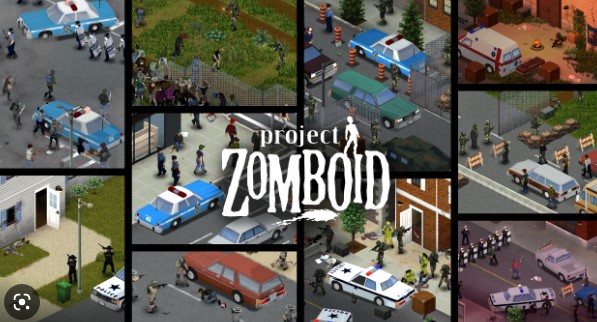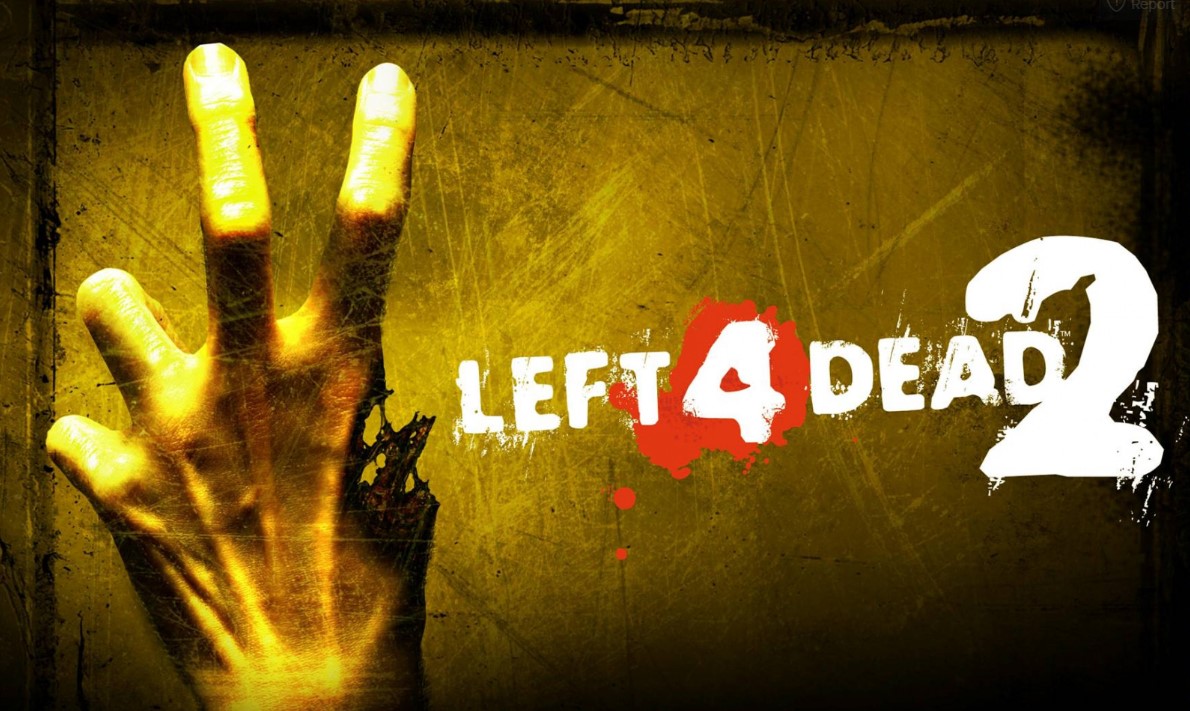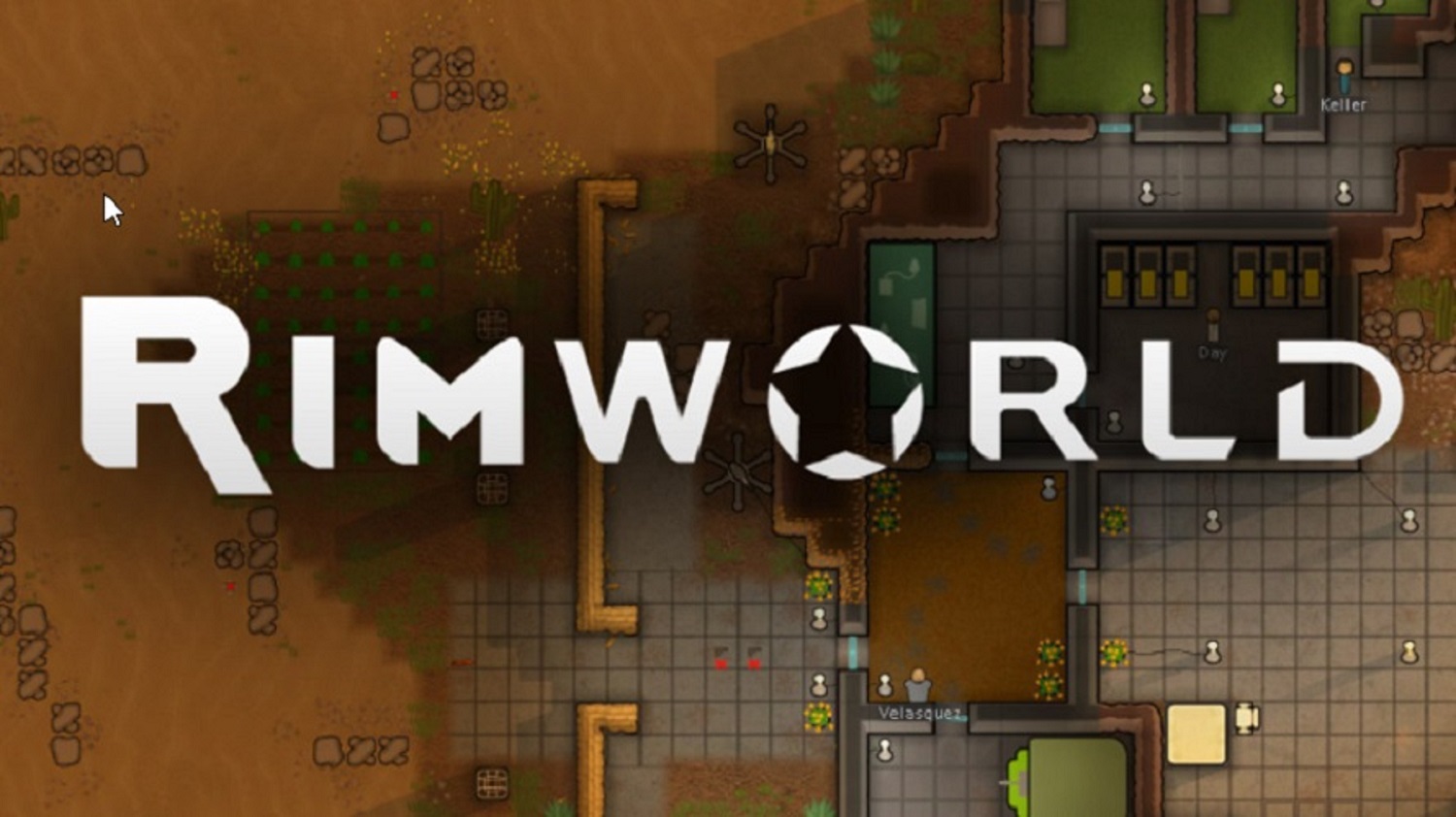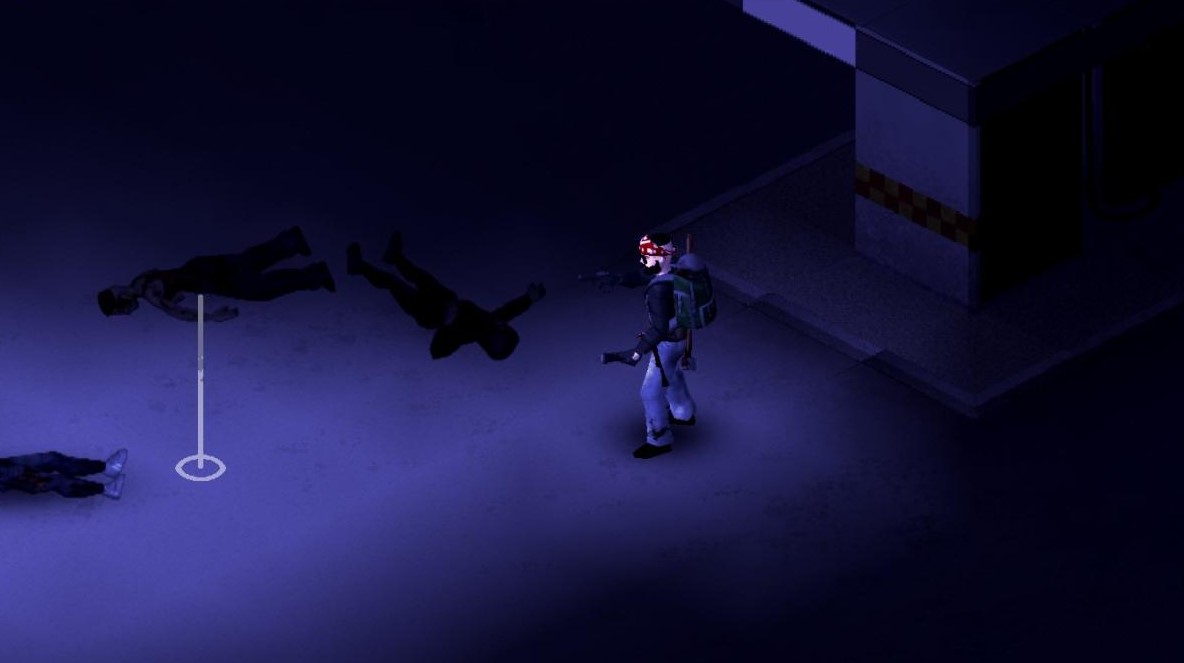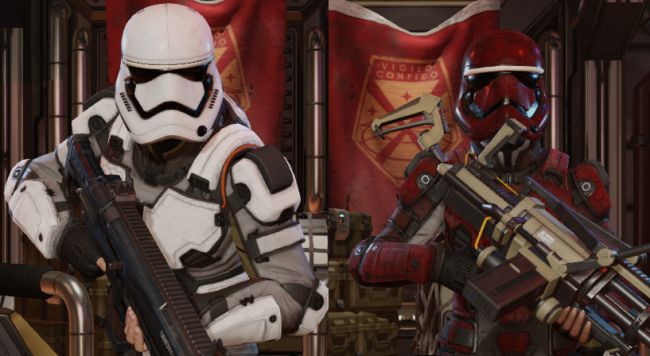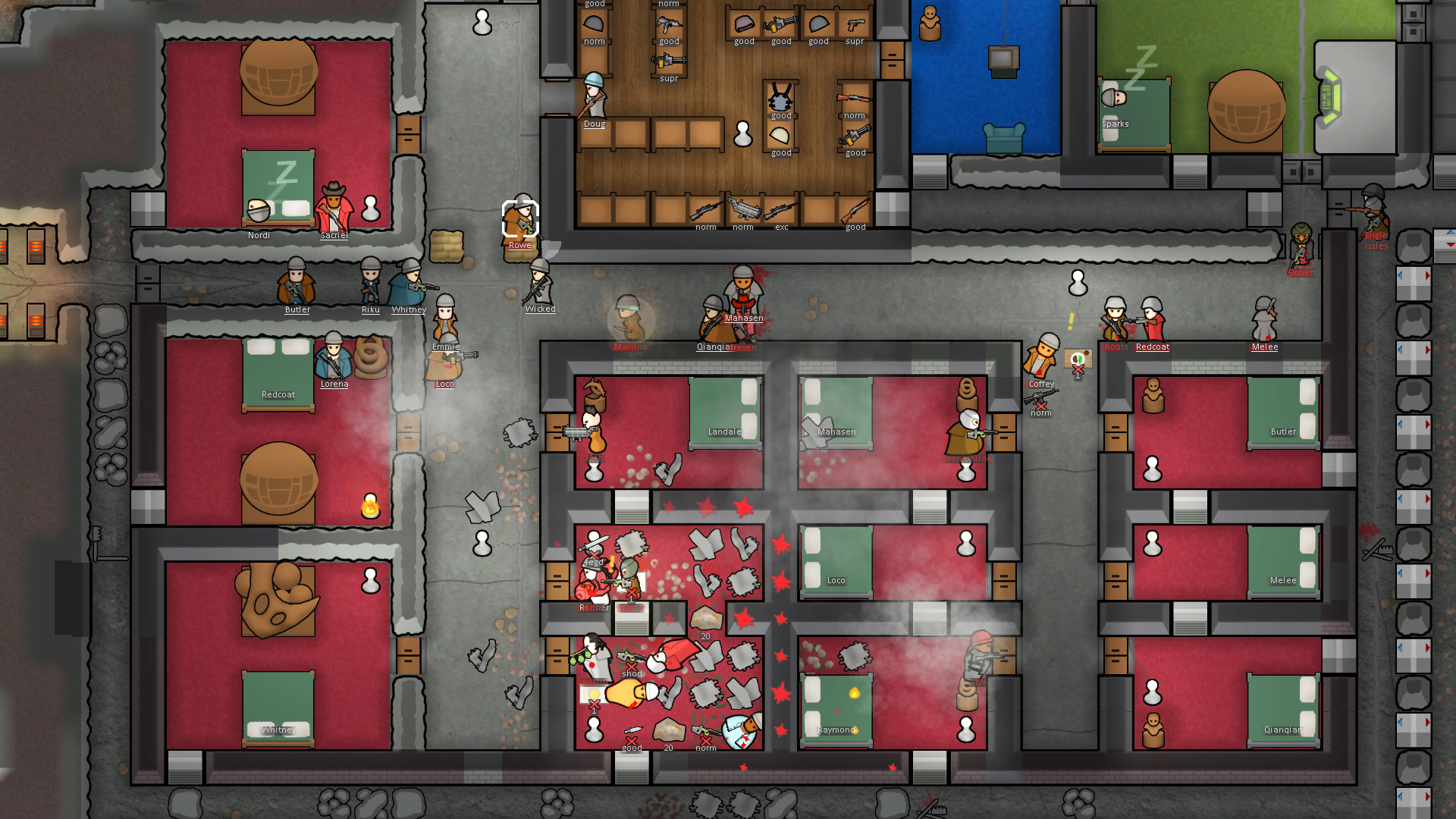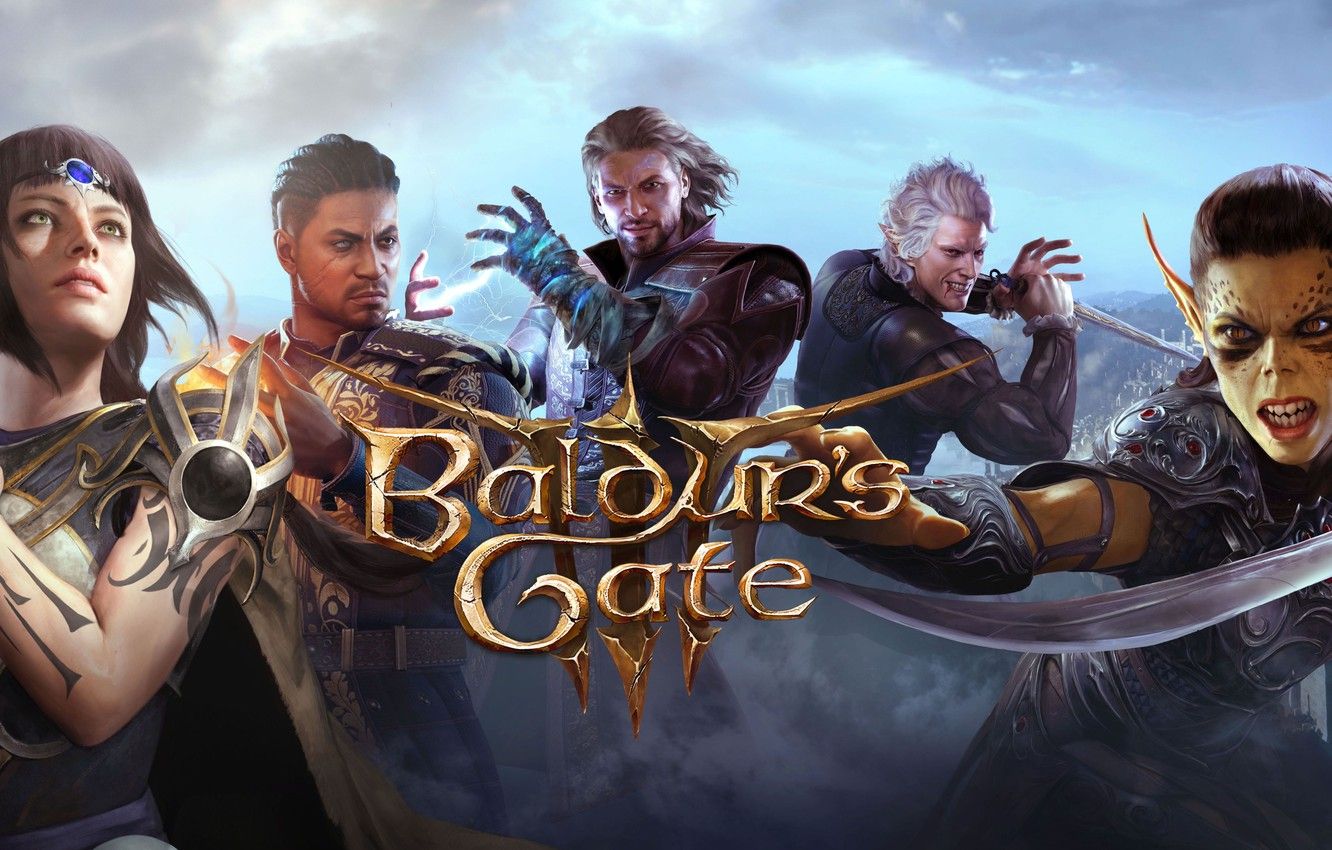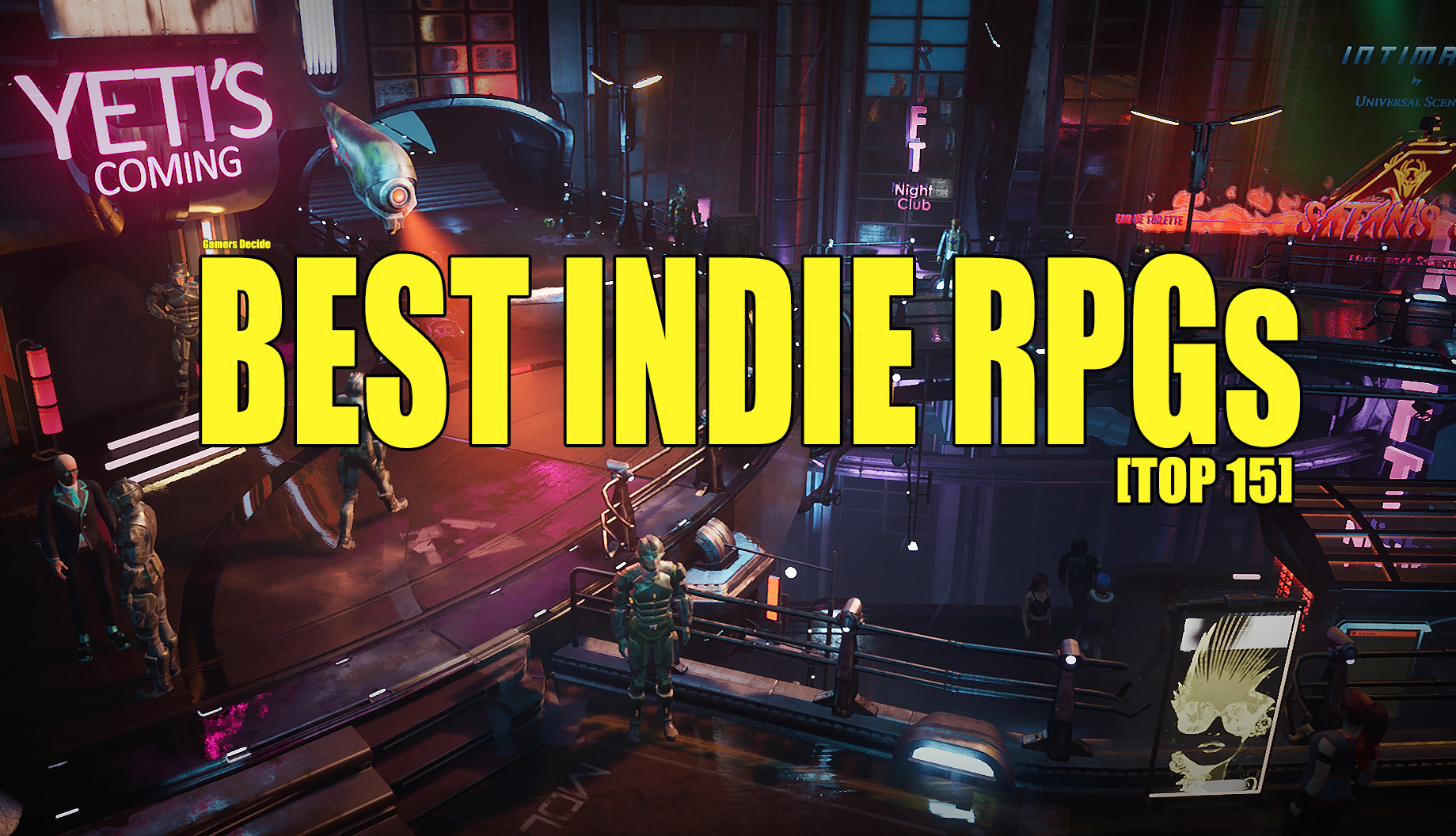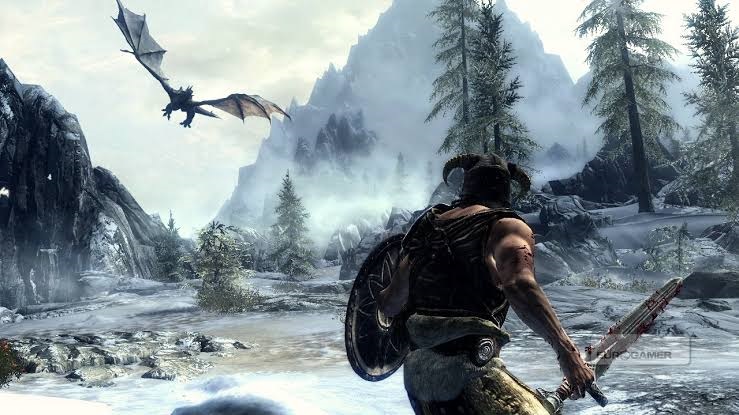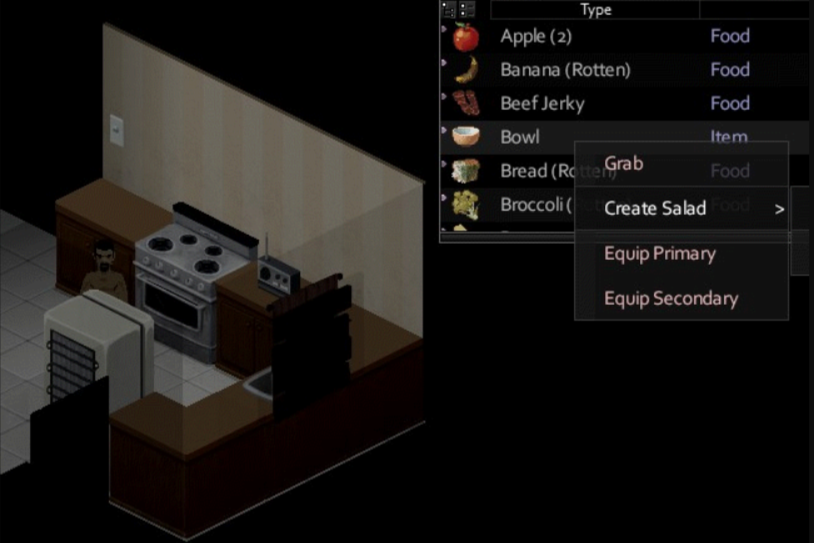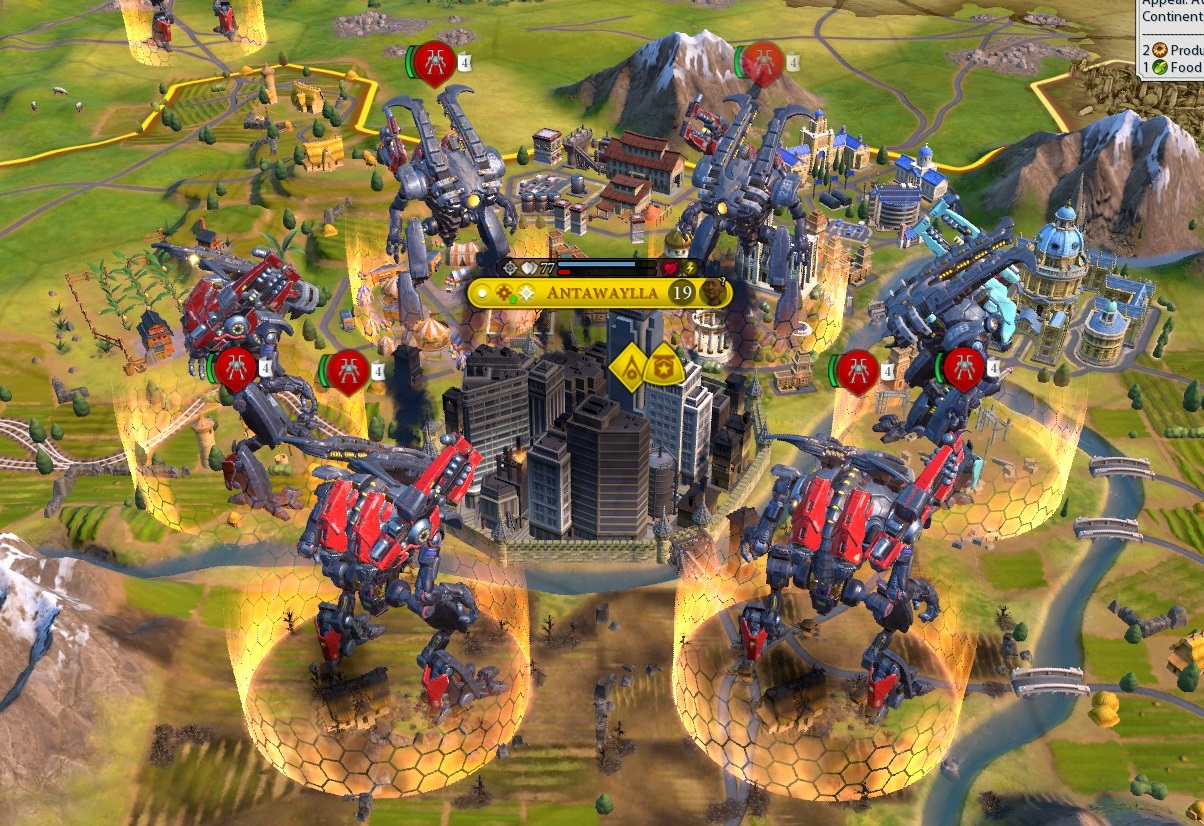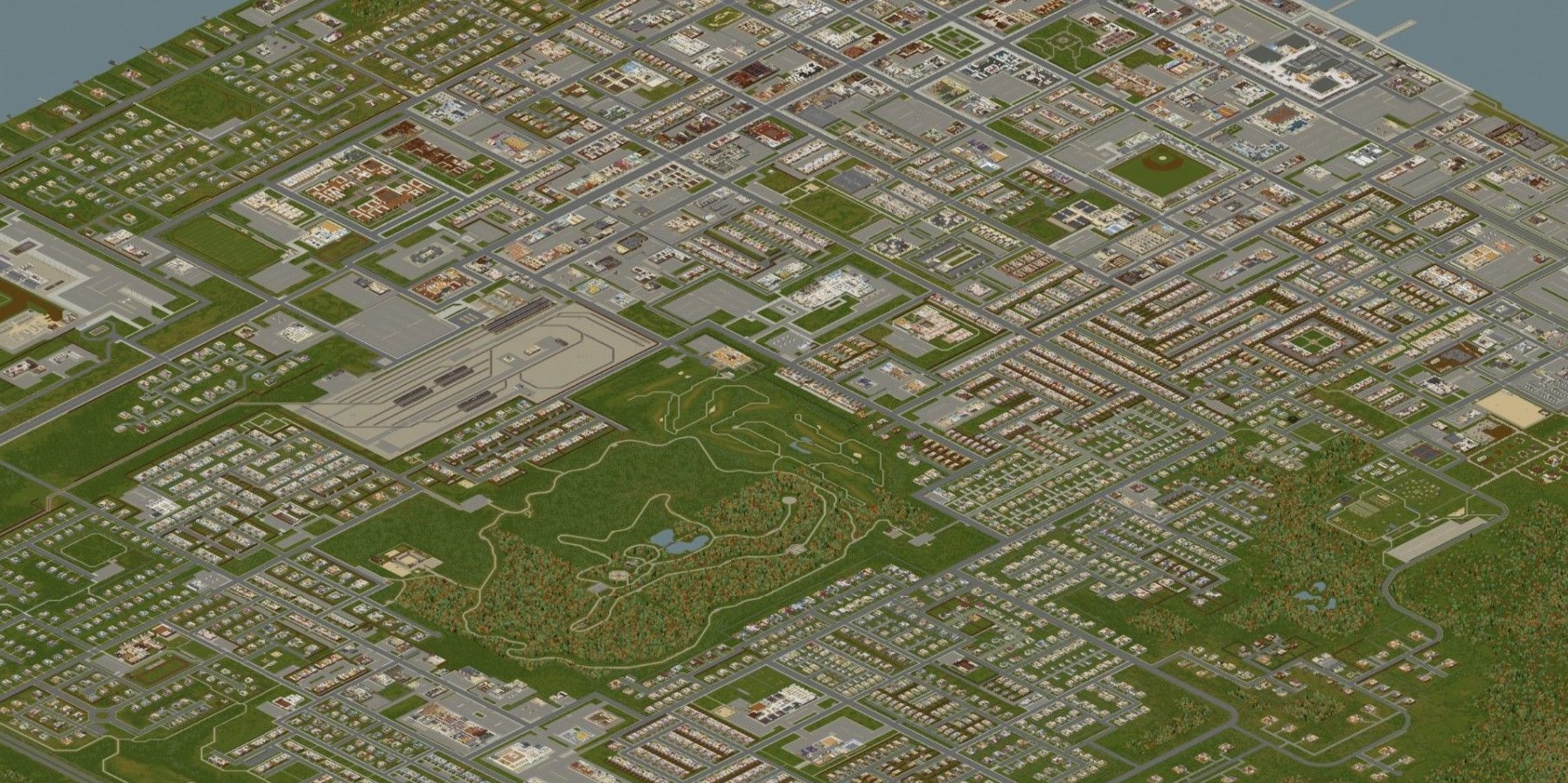![[Top 20] Best Top Down Games For PC Best Top Down Games For PC](/sites/default/files/styles/responsive_image_600xauto/public/2023-12/20_top-down_games_header.jpg.webp?itok=4MDkT9e2)
Some of the best games released back in the day featured top-down visuals, ranging from Sid Meier’s Civilization series to the original Fallout games, and plenty of others that have helped cement this style of gaming as one of the greats. And with so many of the classics featuring this style, it’s only natural that we sit down here today and talk about some of the best modern top-down games in this huge 20-game-sized article! So, let’s not waste time here at the starting line and instead jump right into this list of 20 of the best top-down games you can currently buy on PC. Starting with…
#20: City of Gangsters (PC)
City of Gangsters - Official Gameplay Trailer
Opening up our list at #20, City of Gangsters takes us all the way back to the 1920s at the dawn of Prohibition in the United States, where thanks to congressional action, a huge segment of the national economy became illegal overnight as bars and saloons are ordered to close, distilleries and breweries go quiet, and distributors are shut down. But with the era of legally selling alcohol coming to an end, this is where you come in, a fresh arrival in the city with lofty ambitions of striking it big. And what, you may ask, is the best way to make a fortune in this dawning new era? By building your very own criminal empire from the ground up by building backdoor speakeasies and selling your own under-the-table booze, grabbing opportunity by the horns, and taking control of the city for yourself one crime at a time, that’s how.
City of Gangsters is a unique take on the management tycoon genre, where instead of building a zoo or anything quite as child-friendly, you’re taking full advantage of the roaring twenties’ by hocking homemade hooch and setting up backdoor gambling dens, among the dozens of other illicit activities you can perform to grow your budding criminal empire. Even though you’ll start small, if you’re cunning enough your operations could end up supplying entire neighborhoods as you expand your businesses into new fronts, and offer even more services, which in turn means that you’ll need to hire more hands and keep them paid and armed so they can help deliver your goods and keep your rivals out of your neighborhood. But while rival gang operations are bad, there’s nothing worse than getting caught up in the sights of the cops and the feds. Whether you choose to harass someone or to help them, they’ll be sure to remember it when confronted by the police, so you will need to make your choices carefully and ensure you build connections of trust with your fellow black market businessmen in order to keep your empire afloat.
As you navigate the intricacies of gang warfare and economic dominance in City of Gangsters, the top-down format becomes an essential tool for planning and effectively executing your criminal strategies, while also giving you a bird’s eye view of the ever-growing city and in turn giving you a highly immersive taste of historically accurate 1920s atmosphere. In City of Gangsters, this era belongs to you, so long as you know how to make the most of your situation. Make connections, bribe police officers, and prove that you’re the top dog in the city while you have the chance. Because when 1933 rolls around alcohol will become legal again, and everybody knows that doing business fair-and-square isn’t where the money is.
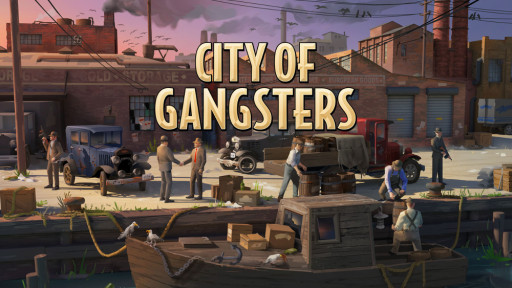
Leverage favors, chase down debtors, and bribe the police to look the other way as you manage production chains and resource distribution, and ultimately form the most powerful crew in the entire city.
#19: The Last Stand: Aftermath (PC/PS4/PS5/Xbox Series X/S)
The Last Stand: Aftermath - Trailer
You might recognize The Last Stand’s title from the classic 2007 Flash game of the same name, along with its two sequel games The Last Stand 2 and The Last Stand: Union City, a collection of browser-based Flash games that used a 2D side-view format. Now, over ten years later, the same development team behind that 2007 Flash game released The Last Stand: Aftermath in November 2021 for Steam. This tense atmospheric experience puts the survival skills of its players to the test, to see if they have what it takes to survive in the ruins of a world where the undead roam free and your time is nearly up.
The Last Stand: Aftermath possesses everything you can expect out of an open-world zombie survival game, from scavenging supplies to making tactical decisions about what you need to do to survive for just one minute longer. On top of the usual resource gathering and the general necessity to be cautious, the game also makes it known that you’re already infected and will eventually die but also uses this fact as a mechanic by giving you the ability to develop powerful mutations that make your character stronger at the risk of “undeath”, which can give you that extra fighting chance you’ll need during a tense encounter with the undead. Your character’s infection is what led them to be exiled from their survivor camp originally, a factor that players into the game’s rogue-lite elements, as after each death you will play as a new random survivor from that camp who is exiled due to infection, and left to explore different regions of the game world, looking for fuel and car parts during their exploration to fix up your car and explore an all-new area, and doing this until you eventually die. With each survivor’s death, you’ll unlock new perks and upgrades to use in your new run, giving the game a sense of replayability that’s as grim as it is fun.
If you were like me as a kid, you loved being able to look up those Flash game collection sites and just pouring away hours into any random number of these small-scale browser games that were developed by a small team of people, or even just one person more often than not. So seeing The Last Stand’s team continue to create games, and doing so in an all-new fashion like with Aftermath, I can’t help but feel nostalgia as I write this post about their latest, and potentially even their greatest game yet. Putting nostalgia aside though, if you enjoy rogue-lite elements and a splash of undead environmental storytelling, The Last Stand: Aftermath serves as an excellent example of a top-down game done right and is surely worth some of your attention.
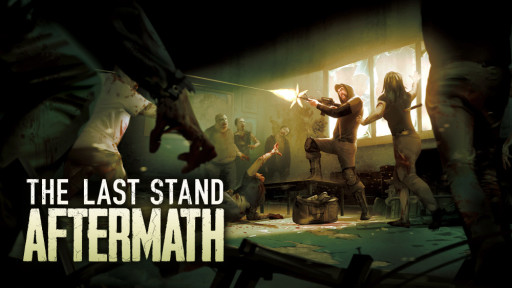
After you become infected by the zombie virus, you set out to explore the post-apocalypse and find hope for your fellow survivors. You can still make a difference. Don't give up.
#18: Warhammer 40,000: Dawn of War II (PC/Mac/Linux)
[HD] Dawn of War 2 - Cinematic Trailer/Intro
Enter the 41st Millennium in the Sub-Sector Aurelia, a cluster of worlds on the edge of the galaxy, where a battle of epic proportions is about to commence as ancient races will clash across the planets that dot this sector of space, battling for the greatest of stakes, not only for control of Sub-Sector Aurelia but the fate of each race. The Warhammer 40,000 universe is brought to life like never before thanks to the fast-paced real-time strategy gameplay of 2009’s Dawn of War II, and puts players in control of some of the most iconic races from the Warhammer universe, including the Space Marines, the Orks, the Eldar, and the Tyranids, along with the Chaos Marines and the Imperial Guard who were added in post-launch expansion packs. So whether you’re playing through the non-linear campaign or one of the other game modes either in single-player or multiplayer, you’re guaranteed fast-action RTS gameplay like no other that will keep you coming back again and again.
Dawn of War II’s gameplay differs greatly from the first Dawn of War and most RTS games in general, with the most obvious difference being that building is completely removed to put more focus on the game’s intense real-time combat, which features a heavier focus on using cover for defensive bonuses like turn-based combat games, along with improved AI and updated weapon mechanics. Instead of focusing on vast armies of units with pre-set stats, Dawn of War II puts the focus on leading smaller squads of soldiers and developing them from raw recruits into the most battle-hardened veterans in the galaxy, where you can upgrade your squads to become stronger throughout the game and further develop their deadly skills. You have a range of weapon choices available across the playable races, which include viscous and visceral melee units and devastating ranged units, on top of a selection of versatile vehicle units, all of which can interact with the dynamic and destructible environments and use them to effectively suppress, flank and ultimately destroy your foes.
The tendrils of the Warhammer franchise extend far and wide both across the tabletop game and video game worlds, and virtually every time they take a step into a certain genre of gaming they do so wonderfully, with Dawn of War II being no exception to that rule. If you’re a fan of the franchise and you don’t mind some slightly dated graphics, Warhammer 40,000: Dawn of War II is a game that’s worth checking out if you haven’t already. And heck, even if you aren’t a Warhammer fan and you’re just looking for a new real-time strategy to try out, Dawn of War II’s unique take on the genre should be enough to draw your interest as well! So why not try dipping your toes outside your comfort zone, eh?
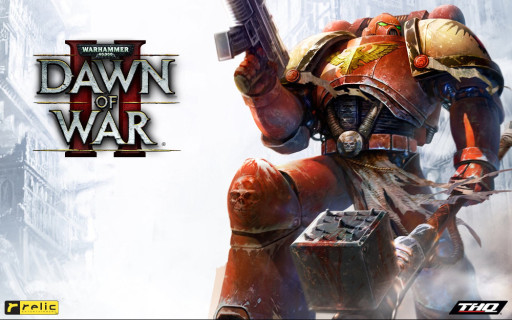
Control squads of elite soldiers from some of the most iconic races in the Warhammer universe and upgrade them to be the deadliest soldiers they can be in your quest to destroy your enemies and take control of the Sub-Sector Aurelia.
#17: Door Kickers 2: Task Force North (PC)
Door Kickers 2 - Announcement Trailer
In Door Kickers 2: Task Force North, you will take control of Special Operations units and lead them across various complex and deadly missions, where using expert tactics and strategy is the key to surviving the many violent encounters you’ll have with terrorist forces in the fictional Middle-Eastern country of Nowheraki. Developed by KillHouse Games, this sequel builds upon the success of its predecessor by refining and expanding the top-down tactical gameplay that made the original Door Kickers a standout title, with the game's top-down perspective allowing its players to meticulously plan and execute high-stakes operations as they breach doors, clear rooms, and neutralize threats with surgical precision. Task Force North boldly brings you one of the best portrayals of modern Close Quarters Combat and Tactics in a video game, and as the game is still in Steam Early Access, the devs promise that they’ll only continue to build upon this already impressive foundation.
True to the violent and dynamic nature of combat in the region, you and your squad will have to prepare for many deadly threats and technologies such as booby traps, suicide bombers, RPGs, and concealed insurgents hiding around every corner, while at the same time the game hands you a truckload of new toys to use against these lurking dangers, including Light Machine Guns for suppressive fire, drone reconnaissance, night vision goggles, and wall breaching charges. Players can carefully analyze the environment of the current map they’re in and position their team members strategically however they see fit to efficiently coordinate simultaneous breaches, all while maintaining an awareness of any potential threats lingering in the shadows. Task Force North doesn’t feature traditional turn-based RTS gameplay, instead removing turns and hexes entirely to allow players freeform planning during each mission.
The game utilizes the top-down style to great effect by allowing for optimized tactical analysis across every non-linear level, which all feature multiple pathways to choose from on top of having highly destructible environments that allow for nearly every wall to be blasted through. On top of having customizable weapon options, Task Force North also has multiple unit types to be used in your squad that each have distinct playstyles, ranging from the Assault class that’s the backbone of every mission, the Grenadier class that packs an explosive punch, the Marksman class that performs best in maps with large open spaces, and even the stealth-specialist CIA class, among a handful of others. And if all of that doesn’t already sound like plenty, the game also features a built-in map editor so you can create your own custom missions, and you can even share them on the Steam Workshop while you’re at it.
With its emphasis on realistic but action-packed and tactically sound top-down gameplay, Door Kickers 2 is one of the best examples of a top-down done right on this list, and we haven’t reached the halfway point yet! The top-down element blends perfectly with the game’s focus on strategy and tactics, and the way it puts you in high-stakes situations where you need to quickly think on your feet is as entertaining as it is intense. Whether you want to go in alone or play alongside a friend in the game’s online co-op multiplayer, Door Kickers 2: Task Force North is a real-time tactics game that I can certainly recommend you play if you love strategy and explosions alike.
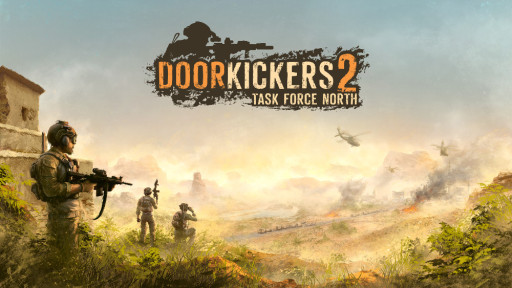
Send in your squad of Special Forces Operatives to take out terrorist cells and rescue kidnapped civilians in gripping real-time tactical combat where there are no turns and no hexes, just fast-paced dynamic action where strategic thinking is the key to victory.
#16: Aliens: Dark Descent (PC/PS4/PS5/Xbox One/Xbox Series X/S)
Aliens Dark Descent - Story Trailer
Our next game is another real-time strategy shooter, but instead of fighting against terrorists in the Middle East, Aliens: Dark Descent pits its players against the nearly unstoppable swarms of Xenomorphs that are massacring their way across the planet Lethe. You will have to take control of a squad of four Colonial Marines, each of which can possess a unique skill set, perks, weapon arsenals, and more, and you’ll need all of these advantages if you want to survive against the Xenomorph plague. Dark Descent tells a gripping original story set in the year 2198, 19 years after the events of the original film trilogy, where players will square off against nearly every iconic monster from the series, ranging from Facehuggers to Praetorians, Alien Queens, and many more, along with the additional threat of rogue human commandos from the Weyland-Yutani Corporation, and even a brand-new mystery threat unique to this Alien storyline…!
In Dark Descent, you will be solely responsible for maintaining not only the health and resources but also their sanity from mission to mission to avoid both permanent team losses and mental breakdowns in the heat of battle. Missions can last anywhere between twenty minutes to an hour depending on how committed or maybe even lucky you are, and take place in a persistently changing world aboard the Pioneer Station orbiting over Planet Lethe, where you can uncover shortcuts or permanently weld passageways shut to prevent enemies from following you, create safe zones for your team to rest in, set up motion detectors to track the movements of the Xenomorph Hive, and a handful of other ways to creatively shape the world around you. This principle applies to the Xenomorphs and other enemies themselves, of course, who can adapt their tactics in response to your actions in real-time, adding an extra layer of danger to an already dangerous world. Luckily, in between missions you can upgrade your home base to unlock new tech, skills, and upgrades for your squad members, helping to make things all the easier over time. If only slightly.
Dark Descent perfectly recaptures the eerie atmosphere of the original Aliens film trilogy, creating a lingering sense of fear always hanging overhead as you try to steel your nerves for the sake of your squad. The gameplay itself does a good job of giving you that top-down RTS experience you were looking for when heading in while also offering plenty of new twists and turns on the formula that help make the game stand out on its own, such as the safe room mechanic and the soldiers’ mental status effects, which help make your squad feel like actual living and possibly dying people instead of just walking guns, for example. If you like your real-time strategy with an extra splash of nerve-tingling terror that forces you into the worst kind of situation to make tactical decisions in, you should put Aliens: Dark Descent on your radar today.
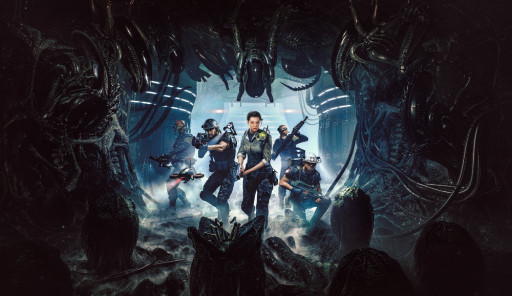
Load up your squad of battle-hardened Colonial Marines to take on the deadly Xenomorph swarm plaguing Planet Lethe, and fight to uncover the mystery of who is behind the industrial sabotage that caused this outbreak.
#15: Age of Wonders 4 (PC/PS5/Xbox Series X/S)
Age of Wonders 4: Empires & Ashes | Announcement Trailer
The latest entry in Triumph Studios’ award-winning strategy series emerged into a new age in May 2023 with the release of Age of Wonders 4, an empire-building strategy game that combines traditional 4X style gameplay (an abbreviation of Explore, Expand, Exploit, Exterminate) with role-playing elements in a high-fantasy world. The powerful Wizard Kings have returned to the realms to reign as gods among the mortals, and as a Wizard King yourself, it’s up to you to decide how you will rule your ever-expanding empire in pursuit of victory. Each new game can take place in a new amalgamation of world elements, from frozen wastelands ruled by ice queens to desolated ruins where dragons roam, ensuring that each new game you play will have an all-new realm to conquer within it, along with the new event system that provides unexpected levels of storytelling for a 4X styled game, allowing you to watch as this dynamic world is reshaped time and again in real-time throughout your game.
When you begin a new game in Age of Wonders 4 and select a realm to play it, you will first need to either select a premade faction to play as or create your own, starting with the “Physical Forms” dictate the appearance of those in your empire, ranging from usual fantasy options like Humans, Elves, Dwarves, and Orcs, to more unusual choices like the Toadmen, Molekin, and Feline options, with each Physical Form possessing their own default set of traits, such as Dwarves having the “Tough” trait that boosts their defense, and Orcs doing bonus damage during attacks. When making custom factions, each race has two main “Body” and “Mind” traits that can be interchanged, meaning you are freely able to customize what race your faction is as well as what abilities they possess, such as creating a faction of magically-gifted Ratkin that have the “Adaptable” Mind trait stat which boosts XP gains. What’s important after your Physical Form is your faction’s Culture and Society, choices that can heavily alter your faction’s affinity, military units, and economy function, affecting which unit types are available at the beginning and how universally usable buildings uniquely work within your faction. If you choose a Barbarian culture, for instance, your military units deal bonus damage on the first melee strike in a battle and gain faster movement speed across the overworld.
Once you have designed your faction’s Physical Form and Culture and Society traits, you will be able to choose your First Tome, which on top of altering your faction’s appearances, such as Demonic Tome types giving your race horns and devilish wings for instance, are the primary way of unlocking new unit types, new abilities, and overall becoming stronger in general, which encourages the player to discover, research and mix-and-match different Tome types throughout gameplay to give yourself an utterly unique boost over the other factions present. Finally, you can select the leader of your faction, which can either be a “Champion”, a hero amongst your people who rose through the ranks of your faction to become a leader of their people, or the aforementioned “Wizard King”, an inter-dimensional conqueror that doesn’t need to match the physical form of your faction, unlike the Champion, meaning that your Wizard King could be a human ruler of a Molekin army if you so choose. Both choices come with unique bonuses, and once you’ve selected your leader type, you’ll then alter their physical appearance and clothing, on top of the types of weapons and equipment you’ll use in battle, meaning your hero can be a melee, ranged, or support focused unit. And once you name your faction and choose your banner… you’re ready to begin playing!
The depth of Age of Wonders 4 comes with the way you can interact with the world and the other factions present in-game, as you can choose entirely whether you’re a diplomatic kind of leader who benefits from mutual agreements with your neighboring rulers, or if you’re the kind of leader to steamroll over all obstacles with an overwhelming horde of units to conquer the world. Unique world storytelling events will alter relations between your factions on the overworld screen, while military units on the battlefield can both battle in a Civilization style overworld fight or in a turn-based up-close and personal battle similar to XCOM, all of which can be affected by the military units you have available, as well as by destructive Tome abilities and other abilities you unlock or encounter across the game, which might just include gigantic magical constructs. The game doesn’t end with victory or defeat, however, as at the end of a game, you might just be able to take your faction leader and ascend them to an in-game pantheon of Gods, unlocking further customization options to the in-game world. When one of your characters ascends to Godhood, you might even encounter your previous creations as allies or enemies in a future game, proving that the story never really ends in Age of Wonders 4.
I was surprised by the level of depth that was available in Age of Wonders 4, especially considering that this game only came out earlier in the year, so I was delightfully surprised by just how much meat was on the proverbial bone with this game. The amount of available creative options combined with the level of freedom to use them however you want is something not seen in many games nowadays, so on that front alone Age of Wonders 4 has already made an explosive launch onto the gaming scene in just six months of being available on Steam. So if you’re a fan of 4X style games and are looking for something new, Age of Wonders 4 gives a unique take on the formula in a way that’s widely different from most other games in the genre and is well worth your time and money in my opinion.

Become a champion of your people or a conquering Wizard King and rule over your growing empire however you desire in one of the most versatile and customizable real-time strategy games released this year.
#14: Going Medieval (PC/Linux)
Update #7 & #8: Beauty & Comfort + Social Interactions | Going Medieval
The similarities between this game and the previous one end in the fact that they are both games about building your kingdom from the ground up, but instead of being a high fantasy 4X strategy game like Age of Wonders, Going Medieval is a city-building and Colony simulation game set in a turbulent medieval age. Developed by Foxy Voxel and published by The Irregular Corporation, this strategy simulation game provides players the means to construct and manage a settlement that they can build from the ground up, and then help guide the settlers of their settlement through the trails and dangers they will face within this procedurally generated world. From your top-down perspective, you will be able to oversee the entire village and watch as your settlers build, farm, trade, fight, live, and die throughout gameplay.
The world of Going Medieval is a deceptively dark one, as you will quickly find that dark age society is all but extinguished, with 95% of the world’s population having perished due to rampant plague by the end of the 14th century. It’s at this moment when survivors emerge from the ashes of society, and it falls on you to help guide them, to lead them from simply surviving in the wilderness to living in comfort within their villages. The top-down view becomes an essential tool for overseeing your settlers as you guide them, first leading them to construct expansive farm plots and houses for food and shelter, expansive castles and walls for protection, and even winding mine systems to gather resources with, then giving them the means to fight off invading raiders, and even to become large enough to trade with neighboring kingdoms. As you shape and grow your population of settlers, so will you unlock new technologies and craftable items to better defend your kingdom with, as well as items that will better the emotional state of your villagers to ensure they can live relatively happy lives instead of just scraping by on survival.
I’ve always been fond of city builders myself, and Going Medieval is just another example in a probably too-long list of games that scratches an itch of mine just right, even when I’m just looking at it. The stylized graphics nicely pair charming visuals with the game’s at-times brutal gameplay, as the scenic sunsets falling over your kingdom only add to the atmosphere of your castle walls being toppled by the catapults of a raiding army of savage bandits, or the cool winter morning hues setting the scene of your villagers digging new grave plots for those that couldn’t last through the foodless winter, among plenty of other views that are uniquely seen thanks to the game’s top-down visuals. Going Medieval is still in Steam early access, so you can expect even more content to come thanks to the game’s semi-regular content updates on top of the expansive medieval life simulation gameplay that’s already present.
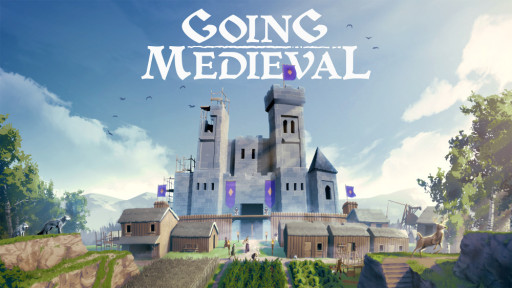
Build an expansive colony of medieval settlers and towering multi-story castles as you fight not only to survive but to live in prosperity within a hostile world where you never know what danger you’ll face next.
#13: Running with Rifles (PC/Mac/Linux)
RUNNING WITH RIFLES - Steam Launch Trailer
In Running with Rifles, players join the ranks of an army during a vast and destructive war and become just another cog in the military machine like the thousands of other soldiers around you. You will be able to do battle across hundreds of open-world maps based on actual battlefields throughout history, from battles in the Pacific to warzones in the Middle East, each features a unique landscape that you can play in, and in turn, shape the flow of battle alongside your teammates. You can play in the main single-player campaign mode, or fight alongside other players either in the online co-op campaign mode or in multiplayer PvP battles, and in each mode, you will have the means to turn the tide of the battle using dozens of weapons, military vehicles, and other times that will at first deceive you into thinking you’re prepared for the fight to come.
The simplistic top-down visuals of Running with Rifles will trick you into thinking that this will be another easy-to-play shooter, when in fact the game uses emergent AI that can use offensive and defensive tactics in real-time against whatever you throw at it, meaning that on higher difficulties you will need to communicate, coordinate, and attack with your AI teammates if you want to successfully push and capture an enemy objective. The extensive single-player campaign is the game’s main feature, using an open-world design, which means that you can either fight alongside your teammates on the front or stealthily sneak around enemy lines to sabotage backline objectives. At the same time, the campaign mode also allows you to adjust the settings and difficulty of both friendly and enemy AI, both of which will counterattack and defend their territories under the orders of their commander, regardless of your input on the battle. You will be able to use dozens of different handheld weapons and mountable gun emplacements, use vehicles like transport trucks full of teammates and tanks, and even call in airstrikes with your radio as you fight across the battlefront. On top of the main objective of winning the battle, the game also features side objectives like destroying radio towers and saving prisoners, among a handful of other ways to keep yourself busy in-game.
Despite being released way back in early 2015, Running with Rifles still sees regular content updates and communication from developers Osumia Games, and still sees hundreds of players online nearly every day. On its surface, this game can be mistaken for being little more than a simplistic top-down war game, but playing Running with Rifles reveals a surprising amount of depth that stands tall among top-down games and as a showcase of what developer commitment can lead to. If you’re looking for a new shooter to get invested in, you need not look further than the hidden gem that is Running with Rifles.

Start as a dime-a-dozen grunt and work your way up to legendary status among your fellow soldiers as you fight across hundreds of open-world battlefronts in Running with Rifles.
#12: Darkwood (PC/Mac/Linux/PS4/PS5/Xbox One/Xbox Series X/S/Nintendo Switch)
Darkwood - Official Launch Trailer | Survival Horror
This next game we’ll be talking about stands as the most unique title on this entire list, as Darkwood takes the top-down genre and gives it a terrifying new twist with its survival horror gameplay. Darkwood’s surreal survival horror experience takes place in a mysterious dark forest somewhere in the European Eastern Bloc, where you and a handful of other main characters have been trapped alongside various nightmarish monstrosities beyond normal comprehension. The game features no hand-holding, no quest markers, and no linear paths, leaving you to find your own path toward survival in Darkwood’s hauntingly atmospheric and psychologically intense survival horror and open-world blend.
Darkwood thrusts players headfirst into a procedurally generated open world that’s different for each new game played, where you can unlock new explorable areas of the game by progressing through the story, which is done by meeting an assortment of eerie characters and deciding their fates through various permanent choices that will impact you, these characters, and the world of Darkwood as a whole, ensuring that no two playthroughs are exactly alike. The day and night cycle of Darkwood make up its two main gameplay phases, as by day you are encouraged to explore as much of the world as you can to scavenge for crafting materials, prepare new weapons for yourself, and even discover new secrets, then once night falls you will have to find shelter to hide within, constructing barricades and various traps to either defend yourself or hide from the monsters lurking in the dark that will leave you questioning your sanity, as the line between reality and nightmarish fantasies will begin to blur. If you survive the night you will earn reputation points which you can spend on the local trader to unlock new items, and you can even discover hallucinogenic fauna and flora that have mutated in this strange forest, which you can use to unlock new skills and perks with the game’s rogue-lite elements. But be careful, some of these plants may provide unforeseen consequences…
Darkwood stands out not only for its horror-filled atmospheric presentation but also for its non-linear narrative and emphasis on player-driven choices, and the consequences that might arise with them. Even with the top-down perspective the game only provides limited visibility, which helps add to the consistent feeling of lingering dread hanging over your head while you try to carefully move through the world, making difficult decisions about resource allocation, and confronting the psychological toll of isolation in the face of the unknown horrors of this psychologically twisted world. Though Halloween has come and gone this year, I still fully suggest that you give this game a try if you’re a fan of psychological horror, as Darkwood forcefully places its players inside a twisted experience that few other top-down games can replicate.

Scavenge and explore a rich, ever-changing free-roam world by day, then hunker down in your hideout and pray for the morning light in Acid Wizard Studio’s eerie and twisted new perspective on survival horror.
#11: Kingdoms and Castles (PC/Mac/Linux)
AI Kingdoms Update Trailer
Similar to a few other games we’ve talked about so far, Kingdoms and Castles is a city-building simulation game about growing your very own kingdom from a tiny hamlet to a sprawling city with an imposing castle overlooking it all. Developed and published by Lion Shield LLC, Kingdoms and Castles offers a charming blend of city-building, strategy, and medieval aesthetics that makes for a whimsical yet challenging experience as players embark on the quest of constructing and managing their own medieval kingdom with the utmost efficiency. In a world filled with dangers, it’s up to you to prevent your villagers from being kidnapped by Viking raiders, or your city from starving during the winter because a dragon burned your granary, and ultimately to ensure that your kingdom thrives by any means necessary.
The gameplay in Kingdoms and Castles is generally straightforward, as the main goal of the game is to construct and maintain your kingdom as efficiently as possible, and you will need to use at least some level of strategic planning when constructing the layout of your city. At the very least, you’ll need to build proper housing facilities and develop enough farmland to house and feed your population, but if you want to ensure that your city’s population remains happy and continues to grow, you’ll also need to make sure your city’s layout is built in a way that generates bonus happiness, while also going out of your way to create buildings like churches to keep your people from despair, taverns to keep them happy, and even town squares to throw lavish festivals for your people. But with all the luxuries of medieval life built, you’ll also need to effectively use the powerful castle-building system to construct walls that will keep out raiding Vikings, archer towers to riddle would-be invaders with arrows, and training barracks to help create other military units when necessary.
The world of Kingdoms and Castles is brought to life through its charming and relaxing visuals, which feature stylized procedurally generated clouds, a season cycle from summer to winter, a tree growth algorithm that realistically simulates the forests of the world, and a handful of other features that further immerse you in the game’s dynamic world. From monitoring the efficiency of your kingdom and its structures to reacting to unexpected events, Kingdoms and Castles combines delightful aesthetics, strategic depth, and engaging gameplay that has a little bit of everything for any fan of city builders out there. Just make sure to keep an eye out for dragons, just in case.
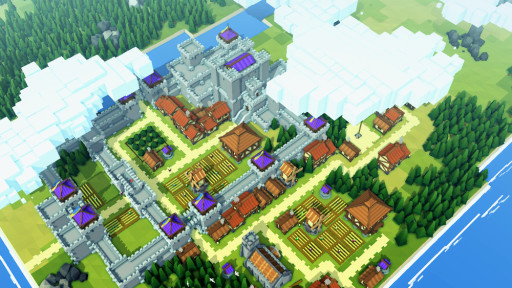
Strategically design the layouts of sprawling cities to feed and house your citizens, then build an imposing castle to protect them from everything that would do them harm, be it from the cold of winter, invading Vikings, or massive dragons soaring overhead.
#10: Prison Architect (PC/Mac/Linux/PS4/Xbox 360/Xbox One/Nintendo Switch/iOS/Android)
Prison Architect
Reaching our halfway mark in this article, we turn our sights to Prison Architect, one of the most well-known building games released on Steam in the last decade or so, where instead of building medieval castles to keep out dangerous threats, you’re tasked with building the most secure supermax prison you possibly can to ensure that the dangerous threats remain inside. In Prison Architect, you start a new game with a barren plot of land and slowly build an entire prison facility from the ground up, laying out the structure of each cell, the guard’s quarters, the yard, and every other piece of the prison puzzle that you’ll need to build the best mostly ethical prison that you can. So long as you have the funding, anyway.
After being hired by the CEO of a for-profit prison company, you’re given the reigns as both the architect and governor of your own prison, where you’ll have to organize and build every inch of your new prison facility to maximize efficiency and ensure your soon-to-be-arriving prisoners can serve their sentence in relative comfort, and at the same time ensuring they can’t escape. On top of managing the prison’s utilities and building specific rooms, you’ll also need to focus your micromanaging on hiring staff members, which include the obvious like guards and doctors along with accountants, psychiatrists, and other civilian staff members that help keep the prison running smoothly. You can even tap federal money with grant applications and use those funds to develop new equipment and programs, such as using it to help combat disease, gang activity, litigation, and more.
Then, once you’ve built every facility you need and hired all the staff for your prison, it’s time for the prisoners themselves to begin arriving by the busload to begin serving their sentence within your prison’s walls. Depending on the bonus DLC packs you’ve purchased, your facilities can house a plethora of different prisoner types, ranging from standard criminals and thugs, to prisoners who are criminally insane and require special psych ward management, death row inmates who will inevitably be executed in your prison, and you can even build an all-female prison that requires special childcare facilities, just in case. You will be the one in charge of scheduling the daily activities of these prisoners to ensure that they perform all their daily activities, as well as encouraging them to participate in reform programs to lighten their sentences and generally ensure that a riot doesn’t break out.
The visual simplicity of Prison Architect is complemented by its intricate gameplay mechanics and attention to detail, as the cartoon art style only serves to mask the actual depth and overall realistic prison experience simulation that Prison Architect achieves. The game's dynamic nature, where each decision has consequences and can impact the overall stability of the prison, is enhanced by the strategic depth afforded by the top-down perspective, from managing the prison budget to handling emergencies and expanding the facility, players are immersed in a challenging and rewarding simulation experience that the top-down format expertly facilitates. As it is one of my more subtle favorites on this list, I can fully recommend trying out Prison Architect if you’re a fan of building sims, micromanagement, and the surprising amount of stress that running a prison can put you under.
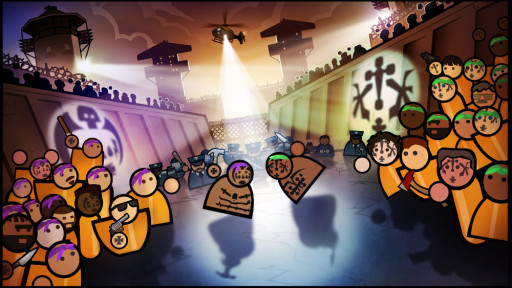
Design and develop your very own personalized penitentiary, and ensure that you and your staff can handle the influx of ruthless prisoners that will be housed in your facility. Remember, only the world’s most ruthless Warden can contain the world’s most ruthless inmates.
#9: Kenshi (PC)
Kenshi: English Trailer
Very few games can make you feel like you’re king of the world and an utterly useless stain on the floor in the same five-minute span on time the way that Kenshi does, as the game is likely the most difficult game on this list, and on top of that it’s likely one of the most difficult open-world games released in the past decade as well. Until 2013 when he was able to hire a small team to help with development, Kensih was developed alone by solo-dev Chris Hunt, who was inspired by stories of wandering rōnin and the idea of a survivor traveling a wasteland when developing the game. Kenshi doesn’t focus on telling a specific narrative story, instead, it puts its focus on sandbox gameplay features that allow for virtually limitless player freedom in a massively scaled open world that constantly wants to kill them, forcing them to grow stronger if they want to survive for longer than a hiccup.
Kenshi takes place in a post-apocalyptic world that’s been largely transformed into inhospitable deserts, scarcely placed forests, putrid swamps, and a manner of other awful places to find yourself in due to what you can find waiting inside, including giant mutated beasts that want to eat you, storm clouds that unleash storms of acid rain, and there’s even an area where an ancient orbital laser randomly scorches the earth during the day. Wherever you go in Kenshi is entirely up to you, as the game doesn’t just avoid holding your hand, but it pushes you off the proverbial cliff and leaves you to explore its vast world however you want, as whoever you want. On top of being able to play as a human, the game features additional playable races, including The Hive, a race of stick-like humanoids that live under a collective mind ruled by their Hive Queens, the Shek, a race of bony, horned humanoids with a culture that values pride, honor, and strength, and finally the Skeletons, which in truth are a race of seemingly fully sentient robots whose origins are shrouded in mystery.
Once you select your character’s race and customize their appearance as you like, you can select one of the 13 “Game Starts” that determine where you start and what you have, which include the “Wanderer” start where you begin at The Hub with a small amount of money and some weak equipment, the “Guy with a Dog” start where you’re a homeless and hungry drifter who adopts a puppy, and then there are more extreme starts like “The Slaves” where you dream of escaping your enslavement by The Holy Nation and “Rock Bottom”, where you spawn without any weapons, clothes, and even without one of your arms in the middle of the desert. The entire point of Kenshi is unlimited player freedom, so with whichever start you do or don’t choose you are free to explore the entire world however you want, so long as it doesn’t kill you first. You can go out and be a trader that travels from village to village selling goods, you can be a bounty hunter capturing rogue criminals for the local sheriffs, you can build your own village and start your own faction, and you can even become a slaver by capturing random individuals from across the wasteland. If there’s something you want to do, you can do it. Just don’t fool yourself into thinking it’ll be easy.
Kenshi is a game that’s not for the faint of heart, meaning that if you ever get the urge to play this game you’re going to have to really commit to it, doing whatever it takes to survive. If you’re reading this list and you’d generally consider yourself a “casual” gamer, you might not be anywhere near prepared for Kenshi. But if you think you have what it takes in order to survive one of the most hostile wastelands ever developed in a video game, then I implore you to give Kenshi a few hours of your time, because those who are prepared will find that it’s just as fun as it can be difficult.

You are not the chosen one. You're not great and powerful. You don't have more 'hitpoints' than everyone else. You are not the center of the universe, and you are not special. Unless you work for it.
#8: XCOM 2 (PC/Mac/Linux/PS4/Xbox One/Nintendo Switch/iOS/Android)
Official XCOM 2 Launch Trailer
It’s been 20 years since the old world leaders offered an unconditional surrender to the invading alien forces and XCOM, the planet’s last line of defense, was left decimated and scattered. Now, the aliens rule the Earth, building glorious cities that shine as an example of the prosperous future they keep promising humanity on the surface, but in truth conceal their sinister agenda to eliminate any and all who resist their new world order. In this sequel to 2012’s award-winning XCOM: Enemy Unknown, you return to the role of XCOM’s Commander after being rescued by resistance forces from your forced alien stasis and resume the fight against the alien invaders-turned overlords to ensure not just your survival, but the survival of all mankind.
While XCOM 2 has a more narrative focus than its predecessor, its overworld strategy and turn-based combat systems remain largely the same at its core, while still using a handful of new features that improve the gameplay. During missions, you control squads of soldiers through turn-based combat encounters, selecting where each soldier moves and which weapons they’ll use on enemies in whatever way you think will best serve the mission. There are five soldier classes that each rookie soldier can become through gameplay, each with their own Soldier Ability. The Ranger wields a melee weapon that slashes enemies, the Grenadier has a grenade launcher and explosives that can destroy enemy cover, the Specialist has a drone that improves the team's defense and health, the Sharpshooter is the team's sniper, and the Psi Operative, which is unlocked late in the game, uses telepathic and psionic powers to boost their allies and cripple their foes. Each class has its own unique set of equipment and comes with two trees of selectable skills that can further make each soldier in your army different from the rest.
XCOM 2 not only features new procedurally generated maps to make each mission more distinct and new equipment and skills for your soldiers but also features a plentiful supply of new enemies to fight alongside memorable classics. The Sectoids and Mutons among others have returned and have been upgraded by fusing with human DNA, alongside new units like the Vipers, the true form of the Thin Men enemies from XCOM 1 who resemble giant snakes and can fittingly ensnare your soldiers and spit acid, the evolved Chryssalids that are terrifying four-legged bug-like enemies who can swiftly race across a battlefield and do devastating melee damage, among over a dozen other unique and deadly enemy variants to encounter. Once you’ve completed a combat mission you will return to the Avenger, a massive alien ship that has been salvaged and refurbished to the XCOM’s base of operations, where you can research new technologies, upgrade your soldiers, study alien technology, and even perform autopsies on alien corpses to understand their weaknesses and develop new weapons and items from them.
The XCOM series is probably one of the main game franchises people think of when they think of top-down games, and for good reason. The methodical turn-based combat and overworld strategy elements require you to think carefully about how best to use your limited resources and crew of soldiers, lest you accidentally lead some of your best men to their sudden and painful deaths. With the game’s turn-based tactical gameplay and deep strategic elements, combined with a rich narrative that responds to player choices, XCOM 2 is a prime example of the top-down genre's ability to deliver challenging and immersive experiences that keep you coming back for more. If you’re reading this article and somehow have never played an XCOM game before, you need to go out right now and get your hands on XCOM 2 to finally see what you’re missing out on. Or wait for a Steam sale if you want, it doesn’t affect me either way.

Earth has changed and is now under the rule of the sinister alien regime. After being awakened from your 20-year stasis, you must return as the commander of XCOM and face impossible odds as you fight to ignite a global resistance, reclaim our world, and save humanity.
#7: Foxhole (PC)
Foxhole Naval Warfare - Announcement Trailer
Of all the top-down military shooters we’ve already talked about in this list, Foxhole stands tall among them as an innovative and immersive entry to the top-down game genre, as Foxhole is a massively multiplayer online game where thousands of players can exist on the same server at once, with every one of them playing a part in shaping the outcome of a persistent online war. Strategy and teamwork are the most important aspects when fighting across Foxhole’s dynamic, ever-changing battlefield, as without each soldier there would be no war to fight. Everything you see on the battlefield, from the firearms in your hands to the tanks storming across the enemy lines, to the elaborate bunker bases that serve as your spawn point in that region, has been supplied, built, and transported by other players across the war, including the bullets loaded inside your rifle, which ensures that your army’s frontline assault is only as strong as its backline supply lines.
When you first load up Foxhole and join the current multi-week-long war that’s currently ongoing, you can either join the green-wearing Colonial Legion or the blue-wearing Wardens, both of which are largely the same as the opposing side save for a handful of weapon and vehicle variants that are unique to that team. You’re free to choose where and how you want to play in Foxhole, as you can either fight alongside dozens or even hundreds of other soldiers defending a town base on the frontline or work with backline logistics to gather materials and refine them into weapons, ammo, gas masks and other equipment that the front needs. The top-down format in Foxhole allows players to witness the grand scope of the conflict as it unfolds in real-time, watching as soldiers charge through weakened defenses alongside a surge of tanks, as massive and complex railroad systems are constructed to bring player-driven trains into the mix, and even as players construct entire missile silos that can wipe out entire towns in seconds.
Foxhole’s player-driven economy is what helps make it one of the most unique top-down games on Steam today, as the game itself proudly proclaims that the players themselves are the game’s content since nothing would get done without the global efforts of players fighting to ensure their team’s victory. If you’re looking to get into Foxhole I would say now is a good time to do it, as this past October Foxhole launched the Naval Warfare major update, which brought in dozens of new naval vessels, ranging from gunboats and destroyers to massive screen-spanning battleships, which are each operated by dozens of players in real-time and each feature in-depth ship simulation, and new ways to incorporate naval tactics and strategy into the ongoing war. So whether you prefer operating tanks or building them, hiding in underground bunkers or undersea submarines, staying on land or charging onto it during massive beach landings, Foxhole is filled to the brim with wartime content for you to engage in, making now the perfect time to enlist and join the war effort!

Take place in massive battles alongside hundreds of other players in a persistent player-driven online war, where every tank driven, medkit used, and even every bullet fired has been built and delivered by one player to another.
#6: Enter the Gungeon (PC/Mac/Linux/PS4/Xbox One/Nintendo Switch)
Enter the Gungeon - Gameplay Trailer
Throughout the galaxy, a legend is told of a grim fortress hidden on a distant planet known as the Gungeon, a mysterious and ever-changing dungeon filled with curses, traps, and most importantly, guns. A LOT of guns. Though the perilous dangers of the Gungeon are known far and wide, it still attracts plenty of foolish individuals who seek to uncover an artifact that supposedly lies at the bottom of the Gungeon: a gun that can kill the past. If you want to change your past, you’ll need to outsmart waves of enemies, defeat deadly bosses, and overall do whatever it takes to survive the endless bullet hell that awaits you once you Enter the Gungeon.
Enter the Gungeon is a bullet hell roguelike dungeon crawler, where you follow the exploits of a band of misfits as they seek to shoot, loot, dodge roll, and table-flip their way to personal absolution by reaching the legendary Gungeon’s ultimate treasure. You can take control of several unlikely heroes when entering the Gungeon, each of which is burdened by a deep regret and in search of a way to change their past no matter the cost, and each with their own starting weapons and usable/passive items in their inventory. The Gungeon isn’t just traps and chasms waiting for you to unwittingly stumble into them, however, as the Gungeon is populated by The Cult of the Gundead, a group of “disciples of the gun” who most commonly take the form of walking person-sized bullets who use the weapons that match the bullet they most visually resemble, among dozens of other uniquely shaped enemies and bosses that await to kill you over and over again within the halls of the Dungeon.
Enter the Gungeon, if you couldn’t tell already, prides itself not only on its highly replayable and award-winning roguelike gameplay but also on the plentiful supply of firearms that can be discovered in the game. You can find a normal selection of weapons like revolvers, shotguns, AK-47s, and other mostly normal weapons, to more unusual weapons like a rifle that freezes enemies, the Witch Pistol which has a chance to transmogrify enemies, the Shell which is a giant shotgun shell that shoots shotguns at enemies, and my personal favorite, the Lower Case r, which looks exactly as the name would lead you to believe and shoots out a burst of six bullets that themselves spell the word “BULLET”. Among these guns, and even the other items you can find and equip throughout the Gungeon, there are a handful of guns that serve as references to notable weapons from throughout various media, including weapons based on the Plasma Cutter from Dead Space, the machine gun The Boss uses in Snake Eater, the Proton gun from Ghostbusters, and many more hidden nods to media’s most iconic firearms, some more hidden than others.
Enter the Gungeon reached its seventh anniversary this year, and looking back on the game now it’s clear to see that this game is still a prime example of a roguelike done right, and another fine addition to our list of top-down games. If you haven’t heard of the game until today, you should go and get your hands on it if you’re a fan of roguelikes, bullet hells, and dungeon crawlers, because Enter the Gungeon takes the very best of all those and more genres and combines them into all-around memorable experience. I mean, there’s even a gun with a skateboard in the game, so how can you resist something as cool as that, right?
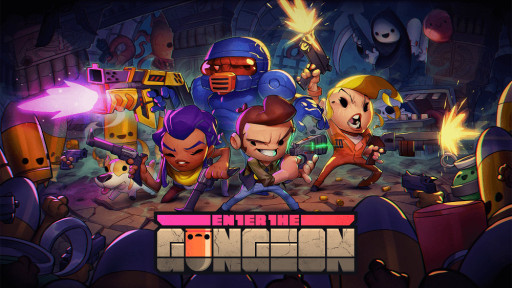
Wield hundreds of uniquely designed guns as you fight through multiple floors of enemies, avoid perilous traps across, and defeat strange and challenging bosses all in the name of reaching Gungeon’s greatest treasure: The Gun That Can Kill The Past.
#5: Don’t Starve (PC/Mac/Linux/PS3/PS4/PS Vita/Xbox One/Nintendo Switch/Wii U/iOS/Android)
Don't Starve - Origin Trailer
Leading us into the Top 5 games on this list is not just one of my favorite games on this list, but one of my all-time favorite PC games in general, with that game being none other than Klei Entertainment’s Don’t Starve. If you haven’t heard of this game before, Don’t Starve is an uncompromising survival game in a mysterious wilderness full of science and magic, where you play as an intrepid Gentleman Scientist named Wilson, along with a few other curious characters, who has been tricked by demonic entities and transported, then subsequently trapped inside to a mysterious and unexplored world full of strange creatures, dangers, and surprises for you to encounter. You’re free to play however you want, but in order to survive in this strange new world, you’ll need to learn to exploit this world’s environment and its strange inhabitants, gathering crafting materials and building structures to aid your survival as you try to unravel the mysteries of this world, and ultimately, try not to starve.
At the beginning of every new save in Don’t Starve you can choose from one of the nineteen(with all DLCs) playable characters that are unlocked through survival and certain feats, and each character comes with a couple of small bonuses and downsides, with Wilson being the default starter character in Don’t Starve who doesn’t come with any downsides, though it’s worth mentioning that he can grow quite the magnificent beard. Once you’ve chosen your character the game will randomly generate a new living and breathing world that wants you to die, and you will have to gather resources like wood and flint to build basic tools, find randomly placed carrots and berry bushes for food, and then continue to gather more complex resources and craft more complex items and machines. On top of tools and crafting machines, you will also need to build weapons to fend off the various deadly creatures that roam this world alongside you, including giant spiders, chess piece-themed robots, viscous packs of hound-like monsters, and even giant monsters like the Dragonfly, Bearger, or the Deerclops. And worst of all, you’ll need to keep your sanity meter high, otherwise, you’ll end up fighting monstrous figments of your imagination. And then there are the creatures that lurk in the dark of night…
Don’t Starve is beloved not just for its engaging and highly replayable survival gameplay, but also for its charming and unique art style that has been positively attributed to the animated films created by Tim Burton, and additionally, its mysterious overarching story about Wilson, the other survivors, and the mysterious world they’re trapped within that is known as “The Constant”. All of those elements and more are what make Don’t Starve one of my favorite indie releases of all time. And if you’re a fan of the survival genre, then I’m confident that Don’t Starve, or alternatively the multiplayer-focused Don’t Starve Together, will become one of your favorite survival games as well if it isn’t already.

After being trapped in a strange and unexplored world full of strange creatures, science, and magic, you must gather resources to craft items and structures to ensure that you don’t starve… in Don’t Starve.
#4: Rimworld (PC/Mac/Linux/PS4/Xbox One)
RimWorld Launch Trailer
Originally inspired by the space western vibe of Firefly, the deep simulation of Dwarf Fortress, and the epic scale of Dune and Warhammer 40,000, Rimworld is a sci-fi colony-building survival sim set in a distant, hostile world. After a spacefaring passenger liner tragically crashes, three survivors who each possess their own random traits, skills, personalities, and backstories crash land in their escape pods in a random part of this largely sized and largely hostile world, and for as random as they might be, they all share one similar aspect: They are survivors, not professional survivalists. Whether your three survivors are cooks, accountants, journalists, or any other number of options, they ultimately will have to band together to build their colony from the ground up if they want to survive, and ultimately build their own spaceship if they ever want to get off this planet alive.
At the start of a new game of Rimworld, you’ll not only select one of six game difficulties to play but also from one of the three available AI storytellers, the main mechanism that determines additional game difficulty and play style, on top of their different styles of random event generation. Cassandra Classic creates story events at a classic increasing curve of difficulty, giving you breathing room between difficult events before pushing another challenge on you again, while Phoebe Chillax will give you enough time between disasters that you’ll forget she’s even there while building your colony, before hitting your colony with the random event equivalent of a ten-ton anvil. Then there’s Randy Random, whose name is entirely accurate as he uses no logic, no rules, just pure randomness to decide what will happen to you next and when it will happen, meaning more often than not he’ll send you extremely difficult and often unfair events to survive, making for quite the dramatic experience. The AI Storyteller in Rimworld is modeled after the AI Director from Valve’s Left 4 Dead series and proves to be just as formidable when analyzing your current situation, taking into account factors such as how wealthy your colony is, how many colonists are present, if any colonists have died recently, and many more factors that are factored into determining what random encounter you will receive next, be it a deadly pirate raid, a fortunate trader caravan visit, or an overwhelming invasion of rabid squirrels. Just to name some examples.
Once you’ve selected an AI Storyteller, the game will generate an entire planet from the poles to the equator for you to try your hand at surviving on, where you can choose wherever you want to land on the planet, from an easygoing experience in a dense forest to the nearly impossible survival conditions of an arid desert or one of the planet’s poles. Then, you get to generate your three starting colonists who each possess their own random assortments of skills and weaknesses as previously mentioned that can affect their survival experience, for example, a survivor with a nobleman background will be better at trading for goods or negotiating a prisoner to become a colonist but refuses to do physical work, while a farm oaf character can expertly grow crops back can’t do scientific research of any kind. Each character in your growing colony can develop a strong friendship that develops into a romance before it's then destroyed by bitterness and hatred, as you never know what dramatic turn your colony will take next in this story of survival.
Every unique biome in Rimworld comes with its own unique set of animals, diseases, and threats to be encountered, along with unique temperatures, rainfalls, mineral resources, and terrain, which all add to the level of challenge that comes with trying to survive in this incredibly harsh environment. With its depth of gameplay, player agency, and the ever-present challenge of creating a successful off-world colony, RimWorld rightfully earns its place not only on this list for being an incredible top-down game but also as an entertaining survival game that’s as fun as it is difficult. If you think you have what it takes to make it off this hostile planet in relatively one piece, I recommend you go and give Rimworld some well-deserved attention.
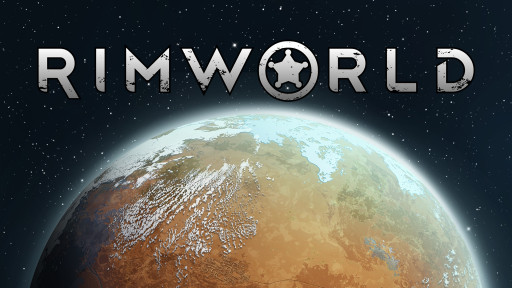
After surviving the destruction of their passenger liner in orbit, three survivors are forced to transform into professional settlers if they want to survive all the hostile intentions that this lonesome planet has in store for them.
#3: Project Zomboid (PC/Mac/Linux)
Project Zomboid Trailer - This Is How I Died
From a hardcore survival game about keeping an entire colony alive, we now turn to a hardcore survival game where the only person looking out for you, is yourself. Project Zomboid, another of my favorites on this list, is an open-ended zombie-infested sandbox that pushes the limits of hardcore survival simulation, just with an added sprinkling of the undead on top. If you want to survive the “Knox Event”, you’ll have to rely on your survival skills, manage your character flaws as best you can, and avoid getting bitten by the infected for as long as you can… in the story of how you died.
When starting a new game in Project Zomboid you will be able to create a custom survivor, choosing not only their appearances but also their previous occupations and traits, which can both give your character additional positive and negative stats. For example, your character’s occupation before the apocalypse started can give you positive stat boosts, such as the Construction Worker occupation giving +1 Carpentry and +3 Short Blunt stat boosts, or the Police Officer giving a bonus to firearm-based stats, while additionally having the chance to spawn you in specific places depending on your starting region. But your character creation process will also need to balance your “trait points”, which determine how many positive traits you can have before you need to select a negative one to balance it out. For example, the Brave trait that reduces your character’s chances of becoming panicked costs four points, so if you’re at negative four points, you’ll need to select a negative trait like Asthmatic that makes you worse at running, or the Smoker trait where you will constantly become stressed unless smoking a cigarette. Other negative traits include making your character Athletic, Obese, Keen Hearing, and even a trait that makes you deaf!
Once your character is created you will enter a fictional, though surprisingly accurate reaction of the state of Kentucky, and are only given the goal of surviving the zombie apocalypse. You will need to gather useful items and food if you want to fight off zombies and stay well-fed, read books to boost your skill stats, craft better items and equipment, and even forms of shelter, and do whatever else you can think of to avoid being torn apart. The game utilizes realistically simulated real-time lighting and a full line of sight and hearing system to add an extra level of deadly detail to the undead, making sure that you’ll want to be as cautious as you can if you want to avoid catching the attention of the dead. If you aren’t too busy running from or fighting the dead, your character will also gain mood attributes such as boredom or depression, among other more positive and even more dreary mood stats, that you will need to manage on top of hunger, thirst, and tiredness.
Project Zomboid excels in delivering one of the most detailed, immersive, and well-crafted zombie survival experiences in a game that’s constantly getting developer updates, making for an at-times terrifying and even hopeless experience that sucks you in and keeps you wanting to put in more and more time into trying to perfect your survival strategies. Not only does it deliver a thrilling zombie survival experience in single-player, but you can also play in online multiplayer lobbies with other players, and even with your friends on the couch via split-screen co-op that supports up to four players at once. We went a good while without talking about zombies during this list, but just like the last game about the walking dead, I’ll say that Project Zomboid is a game well worth playing for anyone who’s a fan of these classic flesh-eating monstrosities.

The zombie apocalypse has arrived at your door, and you will be forced to do whatever it takes to survive this nightmare you find yourself trapped in. But no matter how long you last, in the end, this is still the story of how you died.
#2: Sid Meier’s Civilization VI (PC/Mac/Linux/PS4/Xbox One/Nintendo Switch/iOS/ Android)
CIVILIZATION VI Launch Trailer
Standing as a pinnacle in the top-down genre since the series debuted in 1991, Civilization VI is the latest entry in this long-running series about conducting diplomacy, waging war, advancing your culture, and ultimately building a civilization from the ground up and ensuring that it will stand the test of time. From the Stone Age to the Information Age, a game of Civilization takes you across all of human history as you vie for power and control of an ever-changing world filled with other empires whose leaders want the very same power and control you’re after. You must build towering cities, erect momentous Wonders from across history, and develop both your diplomatic strategies as well as your militaristic strategies if you want to come out on top at the end of the game because, in the end, there can be only one true victor.
The Civilization series has always been a celebration of humanity’s greatest feats throughout history, and can often teach its players even just a little bit of history they didn’t know before while at the same time enduring them through the methodical game of geo-politics and world conquest, which is usually the main focus of the game. If you take all the DLC packs into account, Civilization VI has the most playable Civilizations and selectable leaders to choose from at fifty Civilizations and 76 leaders respectively, each of which is representative of nations, empires, or cultural groups from across human history, which include, among others, the United States under the lead of President Roosevelt, Gandhi leading India, Gilgamesh leading the Sumeria, and many, many more. Some Civilizations like China also include different playable leaders, like Qin Shi Huang as the default leader and Kublai Khan or Wu Zetain as alternate ruler choices. Each playable Civilization and its leaders come with their own specific bonus abilities, units, and infrastructure pieces that can play a major part in determining your victory, so you will need to think carefully about what Civilization best fits your preferred tactics, or what Civilization you think will give you the most entertaining challenge in succeeding with.
Once you have your faction and leader selected, the game will generate a game map that can be altered by choosing certain modifiers, the most prominent being the size of the map itself and the map script you select, which can make the terrain and ocean generation create a map that looks like the whole of Earth to just the Mediterranean or East Asia, then more random options like the more volatile Primordial map script, the 4-Leaf Clover script that’s evenly balanced for four Civilizations, and even a Pangaea script. And when the game loads you onto the map you will have a limited number of turns, that can go up to 1500 total at the slowest game speed, to take your single-city starting empire at the dawn of the Ancient Era and turn it into a bustling, expansive civilization throughout the game by building new structures and cities, creating new monuments and discovering natural wonders, and most importantly, interacting with other civilizations who are all trying to become the best civilization first.
How you choose to go about achieving victory is entirely up to you. Whether you want to rule with militaristic might, create enough culture that draws tourists from across the world to your civilization, or become scientifically advanced enough to create a colony on Mars, the possibilities are there, you just need to take them. The visual elegance of Civilization VI is complemented by its historical charm as well as its intricate gameplay mechanics, with the game’s top-down perspective ensuring players have a comprehensive understanding of the global stage by creating a canvas in which to witness the rise and fall of powerful civilizations throughout history. Whether you want to play alone against AI opponents or in online multiplayer against friends, Civilization VI offers one of the most well-crafted 4X gameplay experiences out there today and has more than earned a spot on this list.

Expand your empire, advance your culture, and go head-to-head against history’s greatest leaders in Civilization VI. Under your guidance, Will your civilization stand the test of time?
#1: Baldur’s Gate 3 (PC/Mac/PS5/Xbox Series X/S)
Baldur's Gate 3 Official Launch Trailer
Considering the monumental success that this game has had in a relatively short time since its full release in August, it might come as no surprise that the game taking out the #1 spot on this list is none other than Baldur’s Gate 3. After you and a handful of other unfortunate individuals have a mind flayer parasite planted in your brains, you find yourselves slowly turning into Illithids yourself and must do whatever it takes to save yourselves from succumbing to such a horrific fate. So it’s up to you to gather your party and head out across the Forgotten Realms in search of a cure, a quest that will take you far and wide in an expansive original story set in the world of the hit tabletop RPG Dungeons & Dragons.
Being heavily based on D&D, Baldur’s Gate 3 is a role-playing game that offers virtually limitless freedom to its players when it comes to its RPG elements, as during your adventures across the game’s grand cinematic adventure, you’ll be free to approach any fight, any conversation, and any important story decision, which includes the ability to kill even critically important story characters at whatever point you want, meaning that you potentially could avoid a difficult boss fight altogether by filling his dungeon with explosive barrels before you even get the quest to go after him, and the game’s flexible quest system means that doing this won’t prevent you from advancing the story either. The open-ended freedom also applies to your character, as while you do have the option to choose from a list of pre-made characters, most of the time players will instead spend potentially hours crafting their custom character to ensure that they will be perfect for the upcoming adventure. You can choose from up to 12 character classes based on Fifth Edition Dungeons & Dragons, which are further subdivided into 46 subclasses. You can then make your character one of the 11 playable races and their subraces, ranging from humans, elves, dwarves, halflings, orcs, and more, which each can have their appearances customized however you like, and each coming with their own race-specific skills, proficiencies, and stat boosts.
The gameplay of Baldur’s Gate 3 is generally what you would expect from an RPG, where you can freely explore an open-world setting set in a series of story chapters, take on quests by talking to various characters and exploring certain places, and of course, engaging in turn-based combat based off the D&D 5E model. And, while all of those features are done excellently thanks to the game’s virtually limitless freedom, what fans of the game really love about it is the way your character interacts with the world around them, specifically with the other characters in your party. Astarion, a High Elf Rogue who carries himself as a charming and confidant nobleman with a biting wit, Shadowheart, a Half-Elf Cleric who though guarded and hesitant cares deeply for other creatures and non-violent solutions, and Gale, a Human Wizard who though somewhat pompous is a good-hearted peace seeker, are just some of the companions that can be recruited in Baldur’s Gate, each of whom has their own personalities and motivations, and affinities that increase or decrease depending on your actions. Each companion has their own backstory and personal character quest that can be unlocked over time as you bond with them, as each companion can not only become your close friend across your adventures, but some of whom can even be romanced if your bond increases enough.
Every single character in Baldur’s Gate 3, both major and minor, is fully voice-acted and motion-captured, which amounts to approximately 1.5 million words of performance capture in total. This level of character interaction, which extends not just to interacting with other characters but the entire living and breathing world of the Forgotten Realms itself, is what makes Baldur’s Gate 3 one of the most in-depth RPGs ever released, and likely the most successful game to come out in all of 2023. If you’re a fan of high-quality role-playing games that truly let you do whatever you want, whether that means being a good-natured savior or a cruel and sadistic evildoer, then Baldur’s Gate 3 is a game that’s well worth your time and money if you haven’t caved and bought it already.
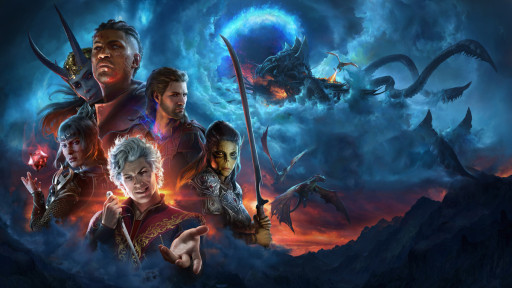
Play as a heroic human paladin, a cruel-hearted half-elf sorcerer, a charismatic halfling bard, and whatever else that you desire thanks to the near-endless role-play possibilities present in Baldur’s Gate 3.
Conclusion
That’s the end of today’s article, and what a list of games that we’ve had for it, eh? From hidden gems to top-selling blockbusters, I like to think that this Top 20 list has had a bit of everything for everyone in it. But what did you think? Did you like every game that you saw, or were there a few examples not listed that you wanted to see instead? If you have any thoughts to share, I would love to read them for myself in the comments! Otherwise, I’ll simply say thank you for reading to the end, and I’ll hope to see you in the next article.
You may also be interested in:


